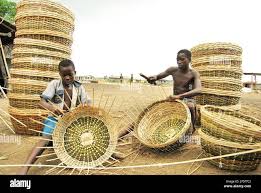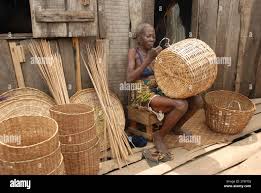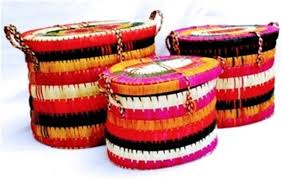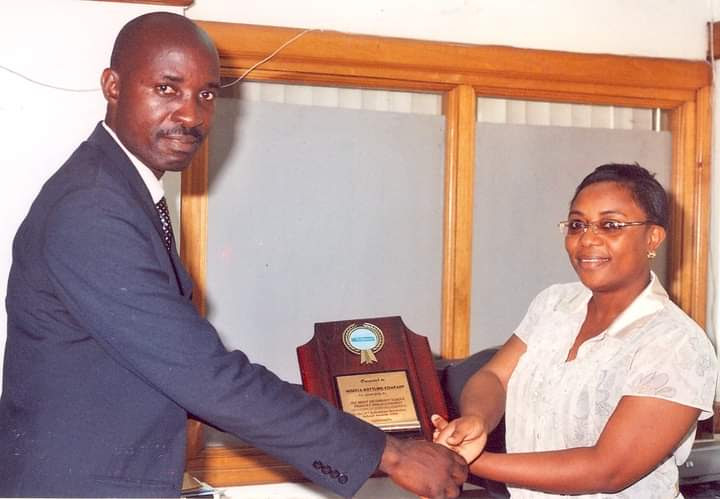![]()
If you’ve landed on this article page, you’re probably searching for a
good business idea—an idea that’s light on the pocket but heavy on
returns, promising both a fulfilling journey and potential profit.
|
How
to start a lucrative Basket weaving Business in Nigeria
Baskets are called kwanduna in Hausa, agbon in Yoruba, nkata in
Anambra State, ekete in Abia, Ebonyi and Enugu State and ide in
Umuahia.
Basketry is one of the oldest craft we know today, however its
origin is unknown and cannot be traced, but it is claimed to be
as old as the igbo race.
Materials for Basket Weaving:
Depending on where you live, you probably have a large variety
of materials that could be used for basket weaving. Grasses and
sedges, invasive vines, foliage from the garden, bark and much
more could be right at your fingertips.
Although there are many variations of twining, the basic version
goes like this (using a spiral base as an example):
basket weaving for beginners, twined basket, basket weaving
instructions, basket weaving tutorial
Step 1: Hold the base securely with your left hand
(non-dominant) with your right hand (dominant weaving hand),
loop a single weaver around the first stake, (See Illustration
above) making one end longer than the other. The short end only
needs to be about 8-10" long at this point.
Step 2: Now you have two weavers. (See Illustration 1.2) The
weaver in front should cross over the weaver coming from behind
and proceed behind the next stake, allowing the weaver from
behind to now be in front of that same stake.
Step 3: Repeat this pattern - the one that's in the front
crosses over the weaver coming from the back and goes behind the
next stake. Each time you create a stitch, firmly pull each
weaver with your right hand while simultaneously pulling up on
the stake with your left hand. This will ensure a tight, uniform
and smooth weave. NOTE: In general, the bigger the basket, the
more movement you'll get in the basket like in my more organic.
Also, fine weavers and stakes help, too!
Simple Cut & Tuck Rim
The Cut & Tuck Rim is a simple way to finish off a basket that
doesn't need a decorative rim. It securely finishes the basket
and gives a nice clean finish. It can also be used as a base for
other more decorative rims, such as the wrapped rim.
Basket weaving materials encompass a diverse range of natural
and recycled elements, each offering unique properties that
influence the final look, durability, and functionality of the
basket. Understanding these materials is paramount for weavers
aiming for successful and meaningful creations.
Reeds and Grasses
Reeds and grasses are among the most commonly used materials in
basket weaving. Ranging from sturdy to flexible, materials like
rattan, willow, cane, and bamboo provide diverse weaving
options. Willow, for instance, is prized for its flexibility,
making it ideal for intricate weaves, while bamboo offers
strength and durability suitable for functional baskets.
These materials are often sourced from specialized suppliers or
can be gathered directly from nature, provided ethical
harvesting practices are observed. Many weavers prefer to
harvest their own materials, ensuring sustainability and a
deeper connection to the craft.
Vines
Vines, such as wisteria, honeysuckle, or grapevine, offer a
different weaving experience. They tend to be more flexible,
allowing for intricate weaving patterns and organic shapes.
However, vines often require soaking or manipulation to achieve
the desired pliability before weaving.
Bark
Many barks are wonderful for weaving when properly prepared.
Both the inner and outer bark of many trees can be used. Thinner
bark trees like mimosa are great for weaving whole. Other
thicker barks like elm, willow, poplar and hickory can be split
and thinned for use.
Newspaper, Fabric Strips, and Plastic
Recycled materials have gained popularity in basket weaving,
offering environmentally friendly alternatives. Newspaper, when
twisted or rolled, mimics the texture and strength of
traditional materials. Similarly, fabric strips from old
clothing or discarded textiles can be braided or woven to create
colorful and unique baskets. Plastic materials, like discarded
grocery bags or plastic straws, can be repurposed creatively.
They require heat treatment or manipulation to ensure
flexibility and cohesion but offer durability and an opportunity
to reduce waste. Metal wire and straps like copper and aluminum
are wonderful weaving materials, too.
The properties of each material significantly impact the weaving
process and the final outcome of the basket. Factors like
flexibility, strength, color, and texture influence the weaving
technique, design possibilities, and the intended use of the
basket.
For instance, a functional basket intended for heavy-duty use
might require a sturdy and resilient material like willow or
rattan. Conversely, a sculptural piece focusing on intricate
designs might benefit from more flexible materials like vines or
softer reeds.
Weavers can find materials through specialty craft stores,
online suppliers, or by gathering natural materials from their
surroundings. Local farms, garden centers, or even recycling
centers might offer a variety of materials ripe for weaving.
Gathering natural materials requires knowledge of seasonal
availability, ethical harvesting techniques, and proper
preparation methods, such as drying or soaking, to ensure
optimal weaving conditions.
Aesthetic Elements
While functionality takes precedence, aesthetic elements are not
overlooked. Functional baskets often exhibit simple yet elegant
designs, incorporating basic weaving techniques that add beauty
without compromising utility. Patterns and colors might be
subtle, complementing the basket's functionality.
basketry artist, basket art, matt tommey, nature art, organic
art, organic sculpture
Woven organic sculpture by basketry artist, Matt Tommey
Sculptural Baskets: Artistry and Expression
Sculptural baskets, on the other hand, are creations celebrated
primarily for their artistic value. They transcend practicality
and serve as artistic expressions, blurring the lines between
traditional craft and fine art.
The creation of sculptural baskets allows weavers the freedom to
experiment with unconventional shapes, intricate designs, and
innovative techniques. These baskets often push the boundaries
of traditional basketry, exploring forms that challenge
perception and provoke thought.
Unlike functional baskets, where utility dictates design,
sculptural baskets prioritize aesthetics. They might feature
intricate weaving patterns, unconventional materials, or
experimental forms intended to evoke emotions or convey a
narrative, showcasing the weaver's artistic prowess.
Sculptural baskets are crafted with the intent of being
displayed as art pieces rather than serving practical purposes.
They find their place in galleries, exhibitions, and
collections, inviting appreciation for the craftsmanship and
artistic vision they embody.
While functional and sculptural baskets differ in purpose and
intent, they often intersect, with some baskets blurring the
lines between the two realms. Talented weavers might infuse
functional baskets with artistic elements, creating pieces that
marry utility with artistic expression.
|







